第十四章习题答案final
- 格式:doc
- 大小:276.50 KB
- 文档页数:6
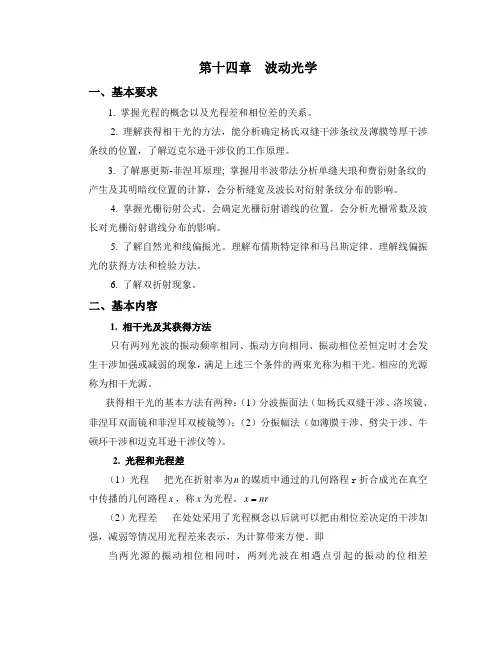
第十四章波动光学一、基本要求1. 掌握光程的概念以及光程差和相位差的关系。
2. 理解获得相干光的方法,能分析确定杨氏双缝干涉条纹及薄膜等厚干涉条纹的位置,了解迈克尔逊干涉仪的工作原理。
3. 了解惠更斯-菲涅耳原理; 掌握用半波带法分析单缝夫琅和费衍射条纹的产生及其明暗纹位置的计算,会分析缝宽及波长对衍射条纹分布的影响。
4. 掌握光栅衍射公式。
会确定光栅衍射谱线的位置。
会分析光栅常数及波长对光栅衍射谱线分布的影响。
5. 了解自然光和线偏振光。
理解布儒斯特定律和马吕斯定律。
理解线偏振光的获得方法和检验方法。
6. 了解双折射现象。
二、基本内容1. 相干光及其获得方法只有两列光波的振动频率相同、振动方向相同、振动相位差恒定时才会发生干涉加强或减弱的现象,满足上述三个条件的两束光称为相干光。
相应的光源称为相干光源。
获得相干光的基本方法有两种:(1)分波振面法(如杨氏双缝干涉、洛埃镜、菲涅耳双面镜和菲涅耳双棱镜等);(2)分振幅法(如薄膜干涉、劈尖干涉、牛顿环干涉和迈克耳逊干涉仪等)。
2. 光程和光程差(1)光程把光在折射率为n的媒质中通过的几何路程r折合成光在真空x中传播的几何路程x,称x为光程。
nr(2)光程差在处处采用了光程概念以后就可以把由相位差决定的干涉加强,减弱等情况用光程差来表示,为计算带来方便。
即当两光源的振动相位相同时,两列光波在相遇点引起的振动的位相差πλδϕ2⨯=∆ (其中λ为真空中波长,δ为两列光波光程差) 3. 半波损失光由光疏媒质(即折射率相对小的媒质)射到光密媒质发生反射时,反射光的相位较之入射光的相位发生了π的突变,这一变化导致了反射光的光程在反射过程中附加了半个波长,通常称为“半波损失”。
4. 杨氏双缝干涉经杨氏双缝的两束相干光在某点产生干涉时有两种极端情况:(1)位相差为0或2π的整数倍,合成振动最强;(2)位相差π的奇数倍,合成振动最弱或为0。
其对应的光程差()⎪⎩⎪⎨⎧-±±=212λλδk k ()()最弱最强 ,2,1,2,1,0==k k 杨氏的双缝干涉明、暗条纹中心位置:dD k x λ±= ),2,1,0( =k 亮条纹 d D k x 2)12(λ-±= ),2,1( =k 暗条纹 相邻明纹或相邻暗纹间距:λd D x =∆ (D 是双缝到屏的距离,d 为双缝间距) 5. 薄膜干涉以21n n <为例,此时反射光要计“半波损失”, 透射光不计“半波损失”。
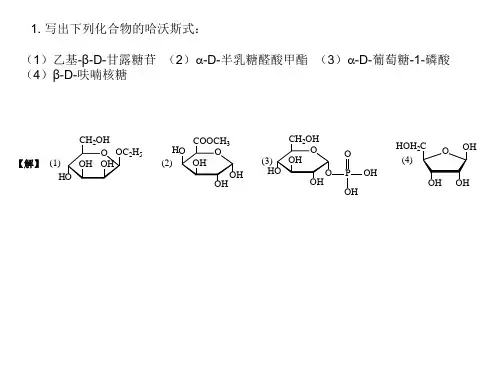

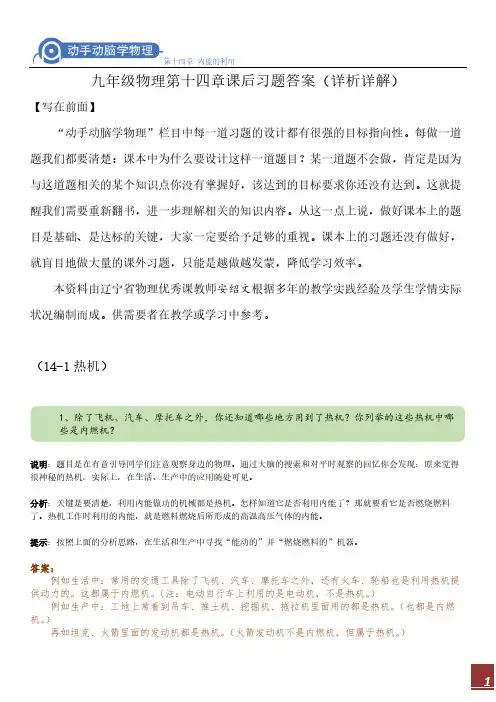
九年级物理第十四章课后习题答案(详析详解)【写在前面】“动手动脑学物理”栏目中每一道习题的设计都有很强的目标指向性。
每做一道题我们都要清楚:课本中为什么要设计这样一道题目?某一道题不会做,肯定是因为与这道题相关的某个知识点你没有掌握好,该达到的目标要求你还没有达到。
这就提醒我们需要重新翻书,进一步理解相关的知识内容。
从这一点上说,做好课本上的题目是基础、是达标的关键,大家一定要给予足够的重视。
课本上的习题还没有做好,就盲目地做大量的课外习题,只能是越做越发蒙,降低学习效率。
本资料由辽宁省物理优秀课教师安绍文根据多年的教学实践经验及学生学情实际状况编制而成。
供需要者在教学或学习中参考。
(14-1热机)说明:题目是在有意引导同学们注意观察身边的物理。
通过大脑的搜索和对平时观察的回忆你会发现:原来觉得很神秘的热机,实际上,在生活、生产中的应用随处可见。
分析:关键是要清楚,利用内能做功的机械都是热机。
怎样知道它是否利用内能了?那就要看它是否燃烧燃料了。
热机工作时利用的内能,就是燃料燃烧后所形成的高温高压气体的内能。
提示:按照上面的分析思路,在生活和生产中寻找“能动的”并“燃烧燃料的”机器。
答案:例如生活中:常用的交通工具除了飞机、汽车、摩托车之外,还有火车、轮船也是利用热机提供动力的。
这都属于内燃机。
(注:电动自行车上利用的是电动机,不是热机。
)例如生产中:工地上常看到吊车、推土机、挖掘机、拖拉机里面用的都是热机。
(也都是内燃机。
)再如坦克、火箭里面的发动机都是热机。
(火箭发动机不是内燃机,但属于热机。
)提示:四冲程内燃机的一个工作循环中,曲轴转动两周,活塞往复运动两次。
分析:(1)已知图甲为吸气冲程(此时活塞在曲轴的带动下向下运动),吸气冲程进气门应该打开、排气门应该关闭,由此可断定各图中左侧为进气门,右侧为排气门。
(2)压缩冲程应该是曲轴带动活塞向上运动,只有两个气门就都应该关闭才能使缸内气体被(见下图乙)。
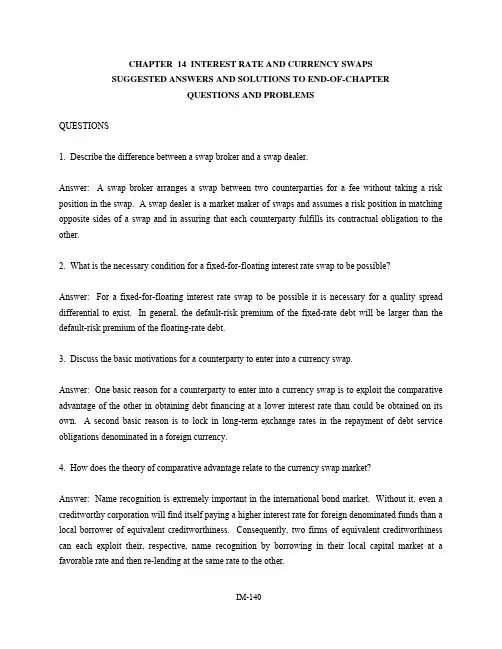
CHAPTER 14 INTEREST RATE AND CURRENCY SWAPSSUGGESTED ANSWERS AND SOLUTIONS TO END-OF-CHAPTERQUESTIONS AND PROBLEMSQUESTIONS1. Describe the difference between a swap broker and a swap dealer.Answer: A swap broker arranges a swap between two counterparties for a fee without taking a risk position in the swap. A swap dealer is a market maker of swaps and assumes a risk position in matching opposite sides of a swap and in assuring that each counterparty fulfills its contractual obligation to the other.2. What is the necessary condition for a fixed-for-floating interest rate swap to be possible?Answer: For a fixed-for-floating interest rate swap to be possible it is necessary for a quality spread differential to exist. In general, the default-risk premium of the fixed-rate debt will be larger than the default-risk premium of the floating-rate debt.3. Discuss the basic motivations for a counterparty to enter into a currency swap.Answer: One basic reason for a counterparty to enter into a currency swap is to exploit the comparative advantage of the other in obtaining debt financing at a lower interest rate than could be obtained on its own. A second basic reason is to lock in long-term exchange rates in the repayment of debt service obligations denominated in a foreign currency.4. How does the theory of comparative advantage relate to the currency swap market?Answer: Name recognition is extremely important in the international bond market. Without it, even a creditworthy corporation will find itself paying a higher interest rate for foreign denominated funds than a local borrower of equivalent creditworthiness. Consequently, two firms of equivalent creditworthiness can each exploit their, respective, name recognition by borrowing in their local capital market at a favorable rate and then re-lending at the same rate to the other.5. Discuss the risks confronting an interest rate and currency swap dealer.Answer: An interest rate and currency swap dealer confronts many different types of risk. Interest rate risk refers to the risk of interest rates changing unfavorably before the swap dealer can lay off on an opposing counterparty the unplaced side of a swap with another counterparty. Basis risk refers to the floating rates of two counterparties being pegged to two different indices. In this situation, since the indexes are not perfectly positively correlated, the swap bank may not always receive enough floating rate funds from one counterparty to pass through to satisfy the other side, while still covering its desired spread, or avoiding a loss. Exchange-rate risk refers to the risk the swap bank faces from fluctuating exchange rates during the time it takes the bank to lay off a swap it undertakes on an opposing counterparty before exchange rates change. Additionally, the dealer confronts credit risk from one counterparty defaulting and its having to fulfill the defaulting party’s obligation to the other counterparty. Mismatch risk refers to the difficulty of the dealer finding an exact opposite match for a swap it has agreed to take. Sovereign risk refers to a country imposing exchange restrictions on a currency involved in a swap making it costly, or impossible, for a counterparty to honor its swap obligations to the dealer. In this event, provisions exist for the early termination of a swap, which means a loss of revenue to the swap bank.6. Briefly discuss some variants of the basic interest rate and currency swaps diagramed in the chapter.Answer: Instead of the basic fixed-for-floating interest rate swap, there are also zero-coupon-for-floating rate swaps where the fixed rate payer makes only one zero-coupon payment at maturity on the notional value. There are also floating-for-floating rate swaps where each side is tied to a different floating rate index or a different frequency of the same index. Currency swaps need not be fixed-for-fixed; fixed-for-floating and floating-for-floating rate currency swaps are frequently arranged. Moreover, both currency and interest rate swaps can be amortizing as well as non-amortizing.7. If the cost advantage of interest rate swaps would likely be arbitraged away in competitive markets, what other explanations exist to explain the rapid development of the interest rate swap market?Answer: All types of debt instruments are not always available to all borrowers. Interest rate swaps can assist in market completeness. That is, a borrower may use a swap to get out of one type of financing and to obtain a more desirable type of credit that is more suitable for its asset maturity structure.8. Suppose Morgan Guaranty, Ltd. is quoting swap rates as follows: 7.75 - 8.10 percent annually against six-month dollar LIBOR for dollars and 11.25 - 11.65 percent annually against six-month dollar LIBOR for British pound sterling. At what rates will Morgan Guaranty enter into a $/£ currency swap?Answer: Morgan Guaranty will pay annual fixed-rate dollar payments of 7.75 percent against receiving six-month dollar LIBOR flat, or it will receive fixed-rate annual dollar payments at 8.10 percent against paying six-month dollar LIBOR flat. Morgan Guaranty will make annual fixed-rate £ payments at 11.25 percent against receiving six-month dollar LIBOR flat, or it will receive annual fixed-rate £ payments at 11.65 percent against paying six-month dollar LIBOR flat. Thus, Morgan Guaranty will enter into a currency swap in which it would pay annual fixed-rate dollar payments of 7.75 percent in return for receiving semi-annual fixed-rate £ payments at 11.65 percent, or it will receive annual fixed-rate dollar payments at 8.10 percent against paying annual fixed-rate £ payments at 11.25 percent.9. A U.S. company needs to raise €50,000,000. It plans to raise this money by issuing dollar-denominated bonds and using a currency swap to convert the dollars to euros. The company expects interest rates in both the United States and the euro zone to fall.a. Should the swap be structured with interest paid at a fixed or a floating rate?b. Should the swap be structured with interest received at a fixed or a floating rate?CFA Guideline Answer:a. The U.S. company would pay the interest rate in euros. Because it expects that the interest rate in the euro zone will fall in the future, it should choose a swap with a floating rate on the interest paid in euros to let the interest rate on its debt float down.b. The U.S. company would receive the interest rate in dollars. Because it expects that the interest rate in the United States will fall in the future, it should choose a swap with a fixed rate on the interest received in dollars to prevent the interest rate it receives from going down.*10. Assume a currency swap in which two counterparties of comparable credit risk each borrow at the best rate available, yet the nominal rate of one counterparty is higher than the other. After the initial principal exchange, is the counterparty that is required to make interest payments at the higher nominal rate at a financial disadvantage to the other in the swap agreement? Explain your thinking.Answer: Superficially, it may appear that the counterparty paying the higher nominal rate is at a disadvantage since it has borrowed at a lower rate. However, if the forward rate is an unbiased predictor of the expected spot rate and if IRP holds, then the currency with the higher nominal rate is expected to depreciate versus the other. In this case, the counterparty making the interest payments at the higher nominal rate is in effect making interest payments at the lower interest rate because the payment currency is depreciating in value versus the borrowing currency.PROBLEMS1. Alpha and Beta Companies can borrow for a five-year term at the following rates:Alpha BetaMoody’s credit rating Aa BaaFixed-rate borrowing cost 10.5% 12.0%Floating-rate borrowing cost LIBOR LIBOR + 1%a. Calculate the quality spread differential (QSD).b. Develop an interest rate swap in which both Alpha and Beta have an equal cost savings in their borrowing costs. Assume Alpha desires floating-rate debt and Beta desires fixed-rate debt. No swap bank is involved in this transaction.Solution:a. The QSD = (12.0% - 10.5%) minus (LIBOR + 1% - LIBOR) = .5%.b. Alpha needs to issue fixed-rate debt at 10.5% and Beta needs to issue floating rate-debt at LIBOR + 1%. Alpha needs to pay LIBOR to Beta. Beta needs to pay 10.75% to Alpha. If this is done, Alpha’s floating-rate all-in-cost is: 10.5% + LIBOR - 10.75% = LIBOR - .25%, a .25% savings over issuing floating-rate debt on its own. Beta’s fixed-rate all-in-cost is: LIBOR+ 1% + 10.75% - LIBOR = 11.75%, a .25% savings over issuing fixed-rate debt.2. Do problem 1 over again, this time assuming more realistically that a swap bank is involved as an intermediary. Assume the swap bank is quoting five-year dollar interest rate swaps at 10.7% - 10.8% against LIBOR flat.Solution: Alpha will issue fixed-rate debt at 10.5% and Beta will issue floating rate-debt at LIBOR + 1%. Alpha will receive 10.7% from the swap bank and pay it LIBOR. Beta will pay 10.8% to the swap bank and receive from it LIBOR. If this is done, Alpha’s floating-rate all-in-cost is: 10.5% + LIBOR - 10.7% = LIBOR - .20%, a .20% savings over issuing floating-rate debt on its own. Beta’s fixed-rate all-in-cost is: LIBOR+ 1% + 10.8% - LIBOR = 11.8%, a .20% savings over issuing fixed-rate debt.3. Company A is a AAA-rated firm desiring to issue five-year FRNs. It finds that it can issue FRNs at six-month LIBOR + .125 percent or at three-month LIBOR + .125 percent. Given its asset structure, three-month LIBOR is the preferred index. Company B is an A-rated firm that also desires to issue five-year FRNs. It finds it can issue at six-month LIBOR + 1.0 percent or at three-month LIBOR + .625 percent. Given its asset structure, six-month LIBOR is the preferred index. Assume a notional principal of $15,000,000. Determine the QSD and set up a floating-for-floating rate swap where the swap bank receives .125 percent and the two counterparties share the remaining savings equally.Solution: The quality spread differential is [(Six-month LIBOR + 1.0 percent) minus (Six-month LIBOR + .125 percent) =] .875 percent minus [(Three-month LIBOR + .625 percent) minus (Three-month LIBOR + .125 percent) =] .50 percent, which equals .375 percent. If the swap bank receives .125 percent, each counterparty is to save .125 percent. To affect the swap, Company A would issue FRNs indexed to six-month LIBOR and Company B would issue FRNs indexed three-month LIBOR. Company B might make semi-annual payments of six-month LIBOR + .125 percent to the swap bank, which would pass all of it through to Company A. Company A, in turn, might make quarterly payments of three-month LIBOR to the swap bank, which would pass through three-month LIBOR - .125 percent to Company B. On an annualized basis, Company B will remit to the swap bank six-month LIBOR + .125 percent and pay three-month LIBOR + .625 percent on its FRNs. It will receive three-month LIBOR - .125 percent from the swap bank. This arrangement results in an all-in cost of six-month LIBOR + .825 percent, which is a rate .125 percent below the FRNs indexed to six-month LIBOR + 1.0 percent Company B could issue on its own. Company A will remit three-month LIBOR to the swap bank and pay six-month LIBOR + .125 percent on its FRNs. It will receive six-month LIBOR + .125 percent from the swap bank. This arrangement results in an all-in cost of three-month LIBOR for Company A, which is .125 percent less than the FRNs indexed to three-month LIBOR + .125 percent it could issue on its own. The arrangements with the two counterparties net the swap bank .125 percent per annum, received quarterly.*4. A corporation enters into a five-year interest rate swap with a swap bank in which it agrees to pay the swap bank a fixed rate of 9.75 percent annually on a notional amount of €15,000,000 and receive LIBOR. As of the second reset date, determine the price of the swap from the corporation’s viewpoint assuming that the fixed-rate side of the swap has increased to 10.25 percent.Solution: On the reset date, the present value of the future floating-rate payments the corporation will receive from the swap bank based on the notional value will be €15,000,000. The present value of a hypothetical bond issue of €15,000,000 with three remaining 9.75 percent coupon payments at the newfixed-rate of 10.25 percent is €14,814,304. This sum represents the present value of the remaining payments the swap bank will receive from the corporation. Thus, the swap bank should be willing to buy and the corporation should be willing to sell the swap for €15,000,000 - €14,814,304 = €185,696.5. Karla Ferris, a fixed income manager at Mangus Capital Management, expects the current positively sloped U.S. Treasury yield curve to shift parallel upward.Ferris owns two $1,000,000 corporate bonds maturing on June 15, 1999, one with a variable rate based on 6-month U.S. dollar LIBOR and one with a fixed rate. Both yield 50 basis points over comparable U.S. Treasury market rates, have very similar credit quality, and pay interest semi-annually.Ferris wished to execute a swap to take advantage of her expectation of a yield curve shift and believes that any difference in credit spread between LIBOR and U.S. Treasury market rates will remain constant.a. Describe a six-month U.S. dollar LIBOR-based swap that would allow Ferris to take advantage of her expectation. Discuss, assuming Ferris’ expectation is correct, the change in the swap’s value and how that change would affect the value of her portfolio. [No calculations required to answer part a.] Instead of the swap described in part a, Ferris would use the following alternative derivative strategy to achieve the same result.b. Explain, assuming Ferris’ expectation is correct, how the following strategy achieves the same result in response to the yield curve shift. [No calculations required to answer part b.]Date Nominal Eurodollar Futures Contract ValueSettlement12-15-97 $1,000,00003-15-98 1,000,00006-15-98 1,000,00009-15-98 1,000,00012-15-98 1,000,00003-15-99 1,000,000c. Discuss one reason why these two derivative strategies provide the same result.CFA Guideline Answera.The Swap Value and its Effect on Ferris’ PortfolioBecause Karla Ferris believes interest rates will rise, she will want to swap her $1,000,000 fixed-rate corporate bond interest to receive six-month U.S. dollar LIBOR. She will continue to hold her variable-rate six-month U.S. dollar LIBOR rate bond because its payments will increase as interest rates rise. Because the credit risk between the U.S. dollar LIBOR and the U.S. Treasury market is expected to remain constant, Ferris can use the U.S. dollar LIBOR market to take advantage of her interest rate expectation without affecting her credit risk exposure.To execute this swap, she would enter into a two-year term, semi-annual settle, $1,000,000 nominal principal, pay fixed-receive floating U.S. dollar LIBOR swap. If rates rise, the swap’s mark-to-market value will increase because the U.S. dollar LIBOR Ferris receives will be higher than the LIBOR rates from which the swap was priced. If Ferris were to enter into the same swap after interest rates rise, she would pay a higher fixed rate to receive LIBOR rates. This higher fixed rate would be calculated as the present value of now higher forward LIBOR rates. Because Ferris would be paying a stated fixed rate that is lower than this new higher-present-value fixed rate, she could sell her swap at a premium. This premium is called the “replacement cost” value of the swap.b. Eurodollar Futures StrategyThe appropriate futures hedge is to short a combination of Eurodollar futures contracts with different settlement dates to match the coupon payments and principal. This futures hedge accomplishes the same objective as the pay fixed-receive floating swap described in Part a. By discussing how the yield-curve shift affects the value of the futures hedge, the candidate can show an understanding of how Eurodollar futures contracts can be used instead of a pay fixed-receive floating swap.If rates rise, the mark-to-market values of the Eurodollar contracts decrease; their yields must increase to equal the new higher forward and spot LIBOR rates. Because Ferris must short or sell the Eurodollar contracts to duplicate the pay fixed-receive variable swap in Part a, she gains as the Eurodollar futures contracts decline in value and the futures hedge increases in value. As the contracts expire, or if Ferris sells the remaining contracts prior to maturity, she will recognize a gain that increases her return. With higher interest rates, the value of the fixed-rate bond will decrease. If the hedge ratios are appropriate, the value of the portfolio, however, will remain unchanged because of the increased value of the hedge, which offsets the fixed-rate bond’s decrease.c. Why the Derivative Strategies Achieve the Same ResultArbitrage market forces make these two strategies provide the same result to Ferris. The two strategies are different mechanisms for different market participants to hedge against increasing rates. Some money managers prefer swaps; others, Eurodollar futures contracts. Each institutional marketparticipant has different preferences and choices in hedging interest rate risk. The key is that market makers moving into and out of these two markets ensure that the markets are similarly priced and provide similar returns. As an example of such an arbitrage, consider what would happen if forward market LIBOR rates were lower than swap market LIBOR rates. An arbitrageur would, under such circumstances, sell the futures/forwards contracts and enter into a received fixed-pay variable swap. This arbitrageur could now receive the higher fixed rate of the swap market and pay the lower fixed rate of the futures market. He or she would pocket the differences between the two rates (without risk and without having to make any [net] investment.) This arbitrage could not last.As more and more market makers sold Eurodollar futures contracts, the selling pressure would cause their prices to fall and yields to rise, which would cause the present value cost of selling the Eurodollar contracts also to increase. Similarly, as more and more market makers offer to receive fixed rates in the swap market, market makers would have to lower their fixed rates to attract customers so they could lock in the lower hedge cost in the Eurodollar futures market. Thus, Eurodollar forward contract yields would rise and/or swap market receive-fixed rates would fall until the two rates converge. At this point, the arbitrage opportunity would no longer exist and the swap and forwards/futures markets would be in equilibrium.6. Rone Company asks Paula Scott, a treasury analyst, to recommend a flexible way to manage the company’s financial risks.Two years ago, Rone issued a $25 million (U.S.$), five-year floating rate note (FRN). The FRN pays an annual coupon equal to one-year LIBOR plus 75 basis points. The FRN is non-callable and will be repaid at par at maturity.Scott expects interest rates to increase and she recognizes that Rone could protect itself against the increase by using a pay-fixed swap. However, Rone’s Board of Directors prohibits both short sales of securities and swap transactions. Scott decides to replicate a pay-fixed swap using a combination of capital market instruments.a. Identify the instruments needed by Scott to replicate a pay-fixed swap and describe the required transactions.b. Explain how the transactions in Part a are equivalent to using a pay-fixed swap.CFA Guideline Answera. The instruments needed by Scott are a fixed-coupon bond and a floating rate note (FRN).The transactions required are to:· issue a fixed-coupon bond with a maturity of three years and a notional amount of $25 million, and· buy a $25 million FRN of the same maturity that pays one-year LIBOR plus 75 bps.b. At the outset, Rone will issue the bond and buy the FRN, resulting in a zero net cash flow at initiation. At the end of the third year, Rone will repay the fixed-coupon bond and will be repaid the FRN, resulting in a zero net cash flow at maturity. The net cash flow associated with each of the three annual coupon payments will be the difference between the inflow (to Rone) on the FRN and the outflow (to Rone) on the bond. Movements in interest rates during the three-year period will determine whether the net cash flow associated with the coupons is positive or negative to Rone. Thus, the bond transactions are financially equivalent to a plain vanilla pay-fixed interest rate swap.7. A company based in the United Kingdom has an Italian subsidiary. The subsidiary generates €25,000,000 a year, received in equivalent semiannual installments of €12,500,000. The British company wishes to convert the euro cash flows to pounds twice a year. It plans to engage in a currency swap in order to lock in the exchange rate at which it can convert the euros to pounds. The current exchange rate is €1.5/£. The fixed rate on a plain vaninilla currency swap in pounds is 7.5 percent per year, and the fixed rate on a plain vanilla currency swap in euros is 6.5 percent per year.a. Determine the notional principals in euros and pounds for a swap with semiannual payments that will help achieve the objective.b. Determine the semiannual cash flows from this swap.CFA Guideline Answera. The semiannual cash flow must be converted into pounds is €25,000,000/2 = €12,500,000. In order to create a swap to convert €12,500,000, the equivalent notional principals are · Euro notional principal = €12,500,000/(0.065/2) = €384,615,385· Pound notional principal = €384,615,385/€1.5/£ = £256,410,257b. The cash flows from the swap will now be· Company makes swap payment = €384,615,385(0.065/2) = €12,500,000· Company receives swap payment = £256,410,257(0.075/2) = £9,615,385The company has effectively converted euro cash receipts to pounds.8. Ashton Bishop is the debt manager for World Telephone, which needs €3.33 billion Euro financing for its operations. Bishop is considering the choice between issuance of debt denominated in: ∙ Euros (€), or∙ U.S. dollars, accompanied by a combined interest rate and currency swap.a. Explain one risk World would assume by entering into the combined interest rate and currency swap.Bishop believes that issuing the U.S.-dollar debt and entering into the swap can lower World’s cost of debt by 45 basis points. Immediately after selling the debt issue, World would swap the U.S. dollar payments for Euro payments throughout the maturity of the debt. She assumes a constant currency exchange rate throughout the tenor of the swap.Exhibit 1 gives details for the two alternative debt issues. Exhibit 2 provides current information about spot currency exchange rates and the 3-year tenor Euro/U.S. Dollar currency and interest rate swap.Exhibit 1World Telephone Debt DetailsCharacteristic Euro Currency Debt U.S. Dollar Currency DebtPar value €3.33 billion $3 billionTerm to maturity 3 years 3 yearsFixed interest rate 6.25% 7.75%Interest payment Annual AnnualExhibit 2Currency Exchange Rate and Swap InformationSpot currency exchange rate $0.90 per Euro ($0.90/€1.00)3-year tenor Euro/U.S. Dollarfixed interest rates 5.80% Euro/7.30% U.S. Dollarb. Show the notional principal and interest payment cash flows of the combined interest rate and currency swap.Note: Your response should show both the correct currency ($ or €) and amount for each cash flow. Answer problem b in the template provided.Template for problem bc. State whether or not World would reduce its borrowing cost by issuing the debt denominated in U.S. dollars, accompanied by the combined interest rate and currency swap. Justify your response with one reason.CFA Guideline Answera. World would assume both counterparty risk and currency risk. Counterparty risk is the risk that Bishop’s counterparty will default on payment of principal or interest cash flows in the swap.Currency risk is the currency exposure risk associated with all cash flows. If the US$ appreciates (Euro depreciates), there would be a loss on funding of the coupon payments; however, if the US$ depreciates, then the dollars will be worth less at the swap’s maturity.b.0 YearYear32 Year1 YearWorld paysNotional$3 billion €3.33 billion PrincipalInterest payment €193.14 million1€193.14 million €193.14 million World receives$3.33 billion €3 billion NotionalPrincipalInterest payment $219 million2$219 million $219 million1 € 193.14 million = € 3.33 billion x 5.8%2 $219 million = $3 billion x 7.3%c. World would not reduce its borrowing cost, because what Bishop saves in the Euro market, she loses in the dollar market. The interest rate on the Euro pay side of her swap is 5.80 percent, lower than the 6.25 percent she would pay on her Euro debt issue, an interest savings of 45 bps. But Bishop is only receiving 7.30 percent in U.S. dollars to pay on her 7.75 percent U.S. debt interest payment, an interest shortfall of 45 bps. Given a constant currency exchange rate, this 45 bps shortfall exactly offsets the savings from paying 5.80 percent versus the 6.25 percent. Thus there is no interest cost savings by sellingthe U.S. dollar debt issue and entering into the swap arrangement.MINI CASE: THE CENTRALIA CORPORATION’S CURRENCY SWAPThe Centralia Corporation is a U.S. manufacturer of small kitchen electrical appliances. It has decided to construct a wholly owned manufacturing facility in Zaragoza, Spain, to manufacture microwave ovens for sale in the European Union. The plant is expected to cost €5,500,000, and to take about one year to complete. The plant is to be financed over its economic life of eight years. The borrowing capacity created by this capital expenditure is $2,900,000; the remainder of the plant will be equity financed. Centralia is not well known in the Spanish or international bond market; consequently, it would have to pay 7 percent per annum to borrow euros, whereas the normal borrowing rate in the euro zone for well-known firms of equivalent risk is 6 percent. Alternatively, Centralia can borrow dollars in the U.S. at a rate of 8 percent.Study Questions1. Suppose a Spanish MNC has a mirror-image situation and needs $2,900,000 to finance a capital expenditure of one of its U.S. subsidiaries. It finds that it must pay a 9 percent fixed rate in the United States for dollars, whereas it can borrow euros at 6 percent. The exchange rate has been forecast to be $1.33/€1.00 in one year. Set up a currency swap that will benefit each counterparty.*2. Suppose that one year after the inception of the currency swap between Centralia and the Spanish MNC, the U.S. dollar fixed-rate has fallen from 8 to 6 percent and the euro zone fixed-rate for euros has fallen from 6 to 5.50 percent. In both dollars and euros, determine the market value of the swap if the exchange rate is $1.3343/€1.00.Suggested Solution to The Centralia Corporation’s Currency Swap1. The Spanish MNC should issue €2,180,500 of 6 percent fixed-rate debt and Centralia should issue $2,900,000 of fixed-rate 8 percent debt, since each counterparty has a relative comparative advantage in their home market. They will exchange principal sums in one year. The contractual exchange rate for the initial exchange is $2,900,000/€2,180,500, or $1.33/€1.00. Annually the counterparties will swap debt service: the Spanish MNC will pay Centralia $232,000 (= $2,900,000 x .08) and Centralia will pay the Spanish MNC €130,830 (= €2,180,500 x .06). The contractual exchange rate of the first seven annual debt service exchanges is $232,000/€130,830, or $1.7733/€1.00. At maturity, Centralia and the Spanish MNC will re-exchange the principal sums and the final debt service payments. The contractual exchange rate of the final currency exchange is $3,132,000/€2,311,330 = ($2,900,000 + $232,000)/(€2,180,500 + €130,830), or $1.3551/€1.00.*2. The market value of the dollar debt is the present value of a seven-year annuity of $232,000 and a lump sum of $2,900,000 discounted at 6 percent. This present value is $3,223,778. Similarly, the market value of the euro debt is the present value of a seven-year annuity of €130,830 and a lump sum of €2,180,500 discounted at 5.50 percent. This present value is €2,242,459. The dollar value of the swap is $3,223,778 - €2,242,459 x 1.3343 = $231,665. The euro value of the swap is €2,242,459 - $3,223,778/1.3343 = -€173,623.。
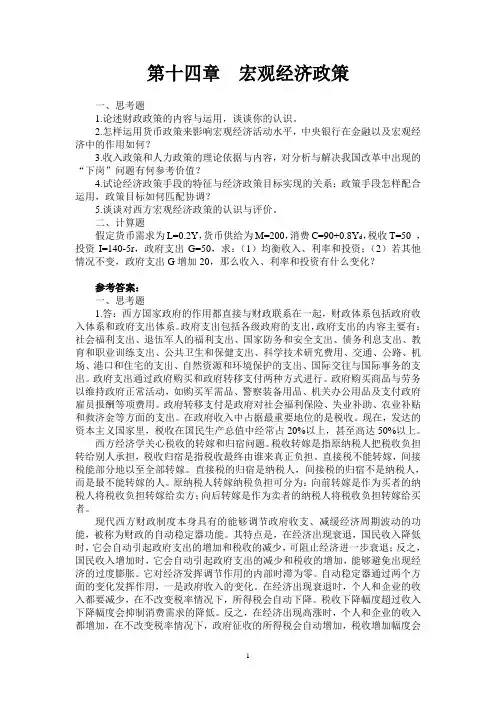
第十四章宏观经济政策一、思考题1.论述财政政策的内容与运用,谈谈你的认识。
2.怎样运用货币政策来影响宏观经济活动水平,中央银行在金融以及宏观经济中的作用如何?3.收入政策和人力政策的理论依据与内容,对分析与解决我国改革中出现的“下岗”问题有何参考价值?4.试论经济政策手段的特征与经济政策目标实现的关系;政策手段怎样配合运用,政策目标如何匹配协调?5.谈谈对西方宏观经济政策的认识与评价。
二、计算题假定货币需求为L=0.2Y,货币供给为M=200,消费C=90+0.8Y d,税收T=50 ,投资I=140-5r,政府支出G=50,求:(1)均衡收入、利率和投资;(2)若其他情况不变,政府支出G增加20,那么收入、利率和投资有什么变化?参考答案:一、思考题1.答:西方国家政府的作用都直接与财政联系在一起,财政体系包括政府收入体系和政府支出体系。
政府支出包括各级政府的支出,政府支出的内容主要有:社会福利支出、退伍军人的福利支出、国家防务和安全支出、债务利息支出、教育和职业训练支出、公共卫生和保健支出、科学技术研究费用、交通、公路、机场、港口和住宅的支出、自然资源和环境保护的支出、国际交往与国际事务的支出。
政府支出通过政府购买和政府转移支付两种方式进行。
政府购买商品与劳务以维持政府正常活动,如购买军需品、警察装备用品、机关办公用品及支付政府雇员报酬等项费用。
政府转移支付是政府对社会福利保险、失业补助、农业补贴和救济金等方面的支出。
在政府收入中占据最重要地位的是税收。
现在,发达的资本主义国家里,税收在国民生产总值中经常占20%以上,甚至高达50%以上。
西方经济学关心税收的转嫁和归宿问题。
税收转嫁是指原纳税人把税收负担转给别人承担,税收归宿是指税收最终由谁来真正负担。
直接税不能转嫁,间接税能部分地以至全部转嫁。
直接税的归宿是纳税人,间接税的归宿不是纳税人,而是最不能转嫁的人。
原纳税人转嫁纳税负担可分为:向前转嫁是作为买者的纳税人将税收负担转嫁给卖方;向后转嫁是作为卖者的纳税人将税收负担转嫁给买者。
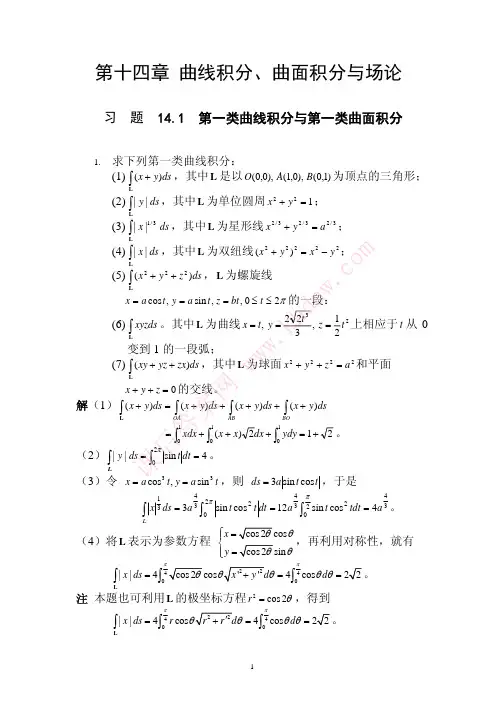

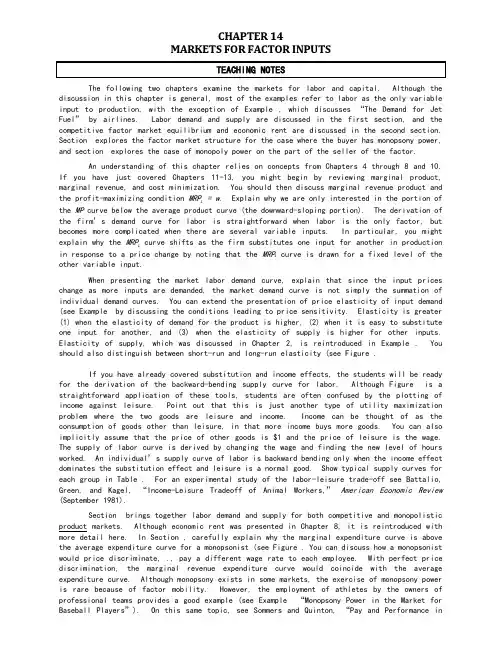
CHAPTER 14MARKETS FOR FACTOR INPUTSThe following two chapters examine the markets for labor and capital. Although the discussion in this chapter is general, most of the examples refer to labor as the only variable input to production, wi th the exception of Example , which discusses “The Demand for Jet Fuel” by airlines. Labor demand and supply are discussed in the first section, and the competitive factor market equilibrium and economic rent are discussed in the second section. Section explores the factor market structure for the case where the buyer has monopsony power, and section explores the case of monopoly power on the part of the seller of the factor.An understanding of this chapter relies on concepts from Chapters 4 through 8 and 10. If you have just covered Chapters 11-13, you might begin by reviewing marginal product, marginal revenue, and cost minimization. You should then discuss marginal revenue product and= w. Explain why we are only interested in the portion of the profit-maximizing condition MRPLthe MP curve below the average product curve (the downward-sloping portion). The derivation of the firm’s demand curve for labor is straightforward when labor is the only factor, but becomes more complicated when there are several variable inputs. In particular, you might curve shifts as the firm substitutes one input for another in production explain why the MRPLin response to a price change by noting that the MRP L curve is drawn for a fixed level of the other variable input.When presenting the market labor demand curve, explain that since the input prices change as more inputs are demanded, the market demand curve is not simply the summation of individual demand curves. You can extend the presentation of price elasticity of input demand (see Example by discussing the conditions leading to price sensitivity. Elasticity is greater (1) when the elasticity of demand for the product is higher, (2) when it is easy to substitute one input for another, and (3) when the elasticity of supply is higher for other inputs. Elasticity of supply, which was discussed in Chapter 2, is reintroduced in Example . You should also distinguish between short-run and long-run elasticity (see Figure .If you have already covered substitution and income effects, the students will be ready for the derivation of the backward-bending supply curve for labor. Although Figure is a straightforward application of these tools, students are often confused by the plotting of income against leisure. Point out that this is just another type of utility maximization problem where the two goods are leisure and income. Income can be thought of as the consumption of goods other than leisure, in that more income buys more goods. You can also implicitly assume that the price of other goods is $1 and the price of leisure is the wage. The supply of labor curve is derived by changing the wage and finding the new level of hours worked. An individual’s supply curve of labor is backward bending only when the inc ome effect dominates the substitution effect and leisure is a normal good. Show typical supply curves for each group in Table . For an experimental study of the labor-leisure trade-off see Battalio, Green, and Kagel, “Income-Leisure Tradeoff of Animal Wo rkers,” American Economic Review (September 1981).Section brings together labor demand and supply for both competitive and monopolistic product markets. Although economic rent was presented in Chapter 8, it is reintroduced with more detail here. In Section , carefully explain why the marginal expenditure curve is above the average expenditure curve for a monopsonist (see Figure . You can discuss how a monopsonist would price discriminate, ., pay a different wage rate to each employee. With perfect price discrimination, the marginal revenue expenditure curve would coincide with the average expenditure curve. Although monopsony exists in some markets, the exercise of monopsony power is rare because of factor mobility. However, the employment of athletes by the owners of professional teams provides a good example (see Example “Monopsony Power in the Market for Baseball Players”). On this same topic, see Sommers and Quinton, “Pay and Performance inMajor League Baseball: The Case of the First Family of Free Agents,” Journal of Human Resources (Summer 1982). Section discusses the case of unions to explore monopoly power on the part of the seller of the input.1. Why is a firm’s demand for labor curve more inelastic when the firm has monopoly power in the output market than when the firm is producing competitivelyThe firm’s demand curve for labor is determined by the incremental revenue fromhiring an additional unit of labor known as the marginal revenue product oflabor: MRPL = (MPL)(MR), the additional output (“product”) that the last workerproduced, times the additional revenue earned by selling that output. In acompetitive industry, the marginal revenue curve is perfectly elastic and equalto price. For a monopolist, marginal revenue is downward sloping. As morelabor is hired and more output is produced, the monopolist will charge a lowerprice and marginal revenue will diminish. All else the same, marginal revenueproduct will be smaller for the monopolist. This implies that the marginalrevenue product for the monopolist is more inelastic than for the competitivefirm.2. Why might a labor supply curve be backward bendingA backward-bending supply curve for labor may occur when the income effect of anincrease in the wage rate dominates the substitution effect. Labor supplydecisions are made by individuals choosing the most satisfying combination ofwork and other (leisure) activities. With a larger income, the individual canafford to work fewer hours: the income effect. As the wage rate increases, thevalue of leisure time (the opportunity cost of leisure) increases, thus inducingthe individual to work longer hours: the substitution effect. Because the twoeffects work in opposite directions, the shape of an individua l’s labor supplycurve depends on the individual’s preferences for income, consumption, andleisure.3. How is a computer company’s demand for computer programmers a derived demandA computer company’s demand for inputs, including programmers, depends on howmany computers it sells. The firm’s demand for programming labor depends on(is derived from) the demand it faces in its market for computers. As demandfor computers shifts, the demand for programmers shifts.4. Compare the hiring choices of a monopsonistic and a competitive employer of workers. Which will hire more workers, and which will pay the higher wages Explain.Since the decision to hire another worker means the monopsonist must pay ahigher wage for all workers, and not just the last worker hired, its marginalexpenditure curve lies above the input supply curve (the average expenditurecurve). The monopsonist’s profit-maximizing input demand, where the marginalexpenditure curve intersects the marginal revenue product curve, will be lessthan the competitor’s profit-maximizing input choice, where the averageexpenditure curve intersects the demand curve. The monopsonist hires less labor,and the wage paid will be less than in a competitive market.5. Rock musicians sometimes earn over $1 million per year. Can you explain such large incomes in terms of economic rentEconomic rent is the difference between the actual payment to the factor ofproduction and the minimum amount that the factor is willing to accept. In thiscase, you might assume that there are a limited number of top-quality rockmusicians who will continue to play rock music no matter what they are paid.This results in a perfectly inelastic supply curve, or something close to it.Given the high demand for rock music, the wage will be very high and there willbe a lot of economic rent. If there was a larger supply of top-quality rockmusicians, or a more elastic supply, then the economic rent would be smaller.6. What happens to the demand for one input when the use of a complementary input increasesIf the demand for the complementary input increases, the demand for the giveninput will increase as well. When demand for the complementary input increases,there is an increase in the quantity hired and possibly the price paid. Both ofthese changes will increase the MRP of the given input, and hence will increasethe quantity hired and possibly the price paid. Whether the prices of theinputs increases depends on the degree of monopsony power on the part of thefirm.7. For a monopsonist, what is the relationship between the supply of an input and the marginal expenditure on itThe decision to increase employment means the monopsonist must pay all units thehigher price, and not just the last unit hired. Therefore, its marginalexpenditure curve lies above the input supply curve (the average expenditurecurve). Hiring more labor will increase the marginal expenditure, which willincrease the average expenditure. If the average expenditure is increasing,then the marginal expenditure must be greater than the average expenditure.8. Currently the National Football League has a system for drafting college players by which each player is picked by only one team. The player must sign with that team or not play in the league. What would happen to the wages of newly drafted and more experienced football players if the draft system were repealed, and all teams could compete for college playersThe National Football League draft and reserve clause (a primary issue in the1987-1988 season’s strike) creates a monopsonist cartel among the owners of NFLteams. If the draft system were repealed, competition among teams would increasewages of football players to the point where the marginal revenue product ofeach player would be equ al to the player’s wage.9. The government wants to encourage individuals on welfare to become employed. It is considering two possible incentive programs for firms.A. Give the firm $2 per hour for every individual on welfare who is hired.B. Give each firm that hires one or more welfare workers a payment of $1000 peryear, irrespective of the number of hires.To what extent is each of these programs likely to be effective at increasing the employment opportunities for welfare workersFirms will hire additional labor as long as the extra benefit is greater thanthe extra cost of hiring the worker, or until MRP L = w. Option A would beeffective because if the firm receives $2 per hour for every welfare workerhired then the effective wage paid, w, will fall and the firm will find itoptimal to hire more labor until the benefits (MRP L) again equal the costs (w)at the margin. Option B would be effective at increasing employmentopportunities also in that if the firm hires an individual who has been onwelfare they will then receive $1000. However, plan B is not necessarily aseffective as plan A given the firm only receives one lump sum paymentregardless of the number of welfare workers hired. In this case the firm onlyhas an incentive to hire the one welfare worker, though they may of coursechoose to hire more than one welfare worker.10. A small specialty cookie company, whose only variable input is labor, finds that the average worker can produce 50 cookies per day, the cost of the average worker is $64 per day, and the price of a cookie is $1. Is the cookie company maximizing its profit Explain.The marginal product of labor is 50 (cookies per day) and the price per cookieis 1 ($ per cookie) so the marginal revenue product is $50/day. Since this isless than the wage of $64 per day the cookie company is not maximizing profit.They are employing too much labor since the cost of labor is greater than thebenefit of labor at the margin, and are therefore producing too many cookies.11. A firm uses both labor and machines in production. Explain why an increase in the average wage rate causes both a movement along the labor demand curve and a shift of the curve.An increase in the wage rate causes an upward movement along the labor demandcurve. For any given marginal revenue product curve, the firm will find thatthey want to hire fewer workers when the wage increases (an upward movement).However, when the wage increases the marginal cost will increase which willreduce desired output. When output falls, the firm will not need as manymachines and the marginal product of labor curve will shift to the left,assuming machines and labor are complementary. This will also reduce thedemand for labor.1. Suppose that the wage rate is $16 per hour, and the price of the product is $2. Values for output and labor are in units per hour.q L0 020 135 247 357 465 570 6a.Find the profit-maximizing quantity of labor.From the information given above, calculate the marginal product of labor, theextra output produced by hiring one more unit of labor, and then multiply byprice to get the marginal revenue product of labor. To find the profit-maximizing quantity of labor, use the rule that the firm wants to hire laboronly as long as the marginal revenue product of labor is greater than thenominal wage, or up to the point where the marginal revenue product of laboris equal to the nominal wage. From the table below, the firm will hire 5units of labor.b.Suppose that the price of the product remains at $2 but that the wage rateincreases to $21. Find the new profit-maximizing quantity of labor.The above table does not change for this part of the problem. However, thefirm no longer wants to hire 5 units of labor because the benefit of the 5thunit ($16 per hour) is less than the cost of the 5th unit ($21 per hour). Thefirm would only hire 3 units of labor per hour since in this case the benefitstill exceeds the cost at the margin. The firm would stick with 3 unitsinstead of 4 unless fractional units are possible. At L=4 the cost is greaterthan the benefit so you lose profit by hiring the 4th unit of labor.c.Suppose the price of the product increases to $3 and the wage remains at $16 perhour. Find the new profit-maximizing quantity of labor.A change in the price of the product will not change the marginal product oflabor, but it will change the marginal revenue product of labor. The newmarginal revenue product of labor is given in the table below. The firm willstill want to hire 5 units of labor, as in part a above. It will not hire the6th unit because the extra benefit is less than the extra cost. Profit will begreater than in part a.d.Suppose that the price of the product remains at $2 and the wage remains at $16,but there is a technological breakthrough that increases output by 25% for any given level of labor. Find the new profit-maximizing quantity of labor.The technological breakthrough changes the number of units of output producedby a given number of units of labor, and hence changes the marginal productand the marginal revenue product of labor. The new output values are found bymultiplying the old values by . This new information is given in the tablebelow. The firm will still choose to hire 5 units of labor. Profit will begreater than in part a.6,0003,0002,000 5,0007,0003,5001,500 5,0008,0004,0001,000 5,0009,0004,500 500 5,00010,0005,000 0 5,0003. Using your knowledge of marginal revenue product, explain the following:a. A famous tennis star is paid $100,000 for appearing in a 30-second televisioncommercial. The actor who plays his doubles partner is paid $500.Marginal revenue product of labor, MRP, is equal to marginal revenue from anLincremental unit of output multiplied by the marginal product from anincremental unit of labor, or in other words, the extra revenue generated byhaving the tennis star appear in the ad. The famous tennis star is able to helpincrease revenues far more than the actor, so he is paid much more than theactor. The wage of the actor is determined by the supply and demand of actorswilling to play tennis with tennis stars.b. The president of an ailing savings and loan is paid not to stay in his job for thelast two years of his contract.The marginal revenue product of the president of the ailing savings and loan islikely to be negative and therefore, the savings and loan is better off bypaying the president not to show up. They have calculated that they will loseless (or gain more) by paying the president off and hiring someone else.c. A jumbo jet carrying 400 passengers is priced higher than a 250-passenger model eventhough both aircraft cost the same to manufacture.The ability of the larger jet to generate more revenue increases its value tothe airline, and therefore the airline is willing to pay more for it.4. The demands for the factors of production listed below have increased. What can you conclude about changes in the demand for the related consumer goods If demands for the consumer goods remain unchanged, what other explanation is there for an increase in derived demands for these itemsa. Computer memory chipsIn general, an increase in the demand for a good increases the demand for itsfactor inputs. The converse is not necessarily true; ., an increase in thedemand for factor inputs does not necessarily imply an increase in the demandfor the final product. The demand for an input may increase due to a change inthe use of other inputs in the production process. As the price of anotherinput increases, its demand falls and the demand of substitutable inputs rises.In this case, the increase in the demand for computer memory chips must havebeen caused by an increase in the demand for personal computers given thatcomputer memory chips are used only in computers, and there are no substitutesfor computer memory chips.b. Jet fuel for passenger planesWith an increase in the demand for jet travel, the demand for jet fuel willincrease. There are no substitutes for jet fuel.c. Paper used for newsprintGiven the paper is being used to print newspapers then there must have been anincrease in the circulation of newspapers.d. Aluminum used for beverage cansWith an increase in demand for cold drinks in the summer, the seasonal demandfor aluminum increases, so this is one possible explanation. Alternatively, ifglass or plastic have become more expensive then this may affect the demand foraluminum. Finally, changes in the market for recycled aluminum may affect thedemand for new aluminum.5. Suppose there are two groups of workers, unionized and nonunionized. Congress passes a law that requires all workers to join the union. What do you expect to happen to the wage rates of formerly nonunionized workers of those workers who were originally unionized What have you assumed about the union’s behaviorIn general, we expect that nonunionized workers are earning lower wages thanunionized workers. If all workers are forced to join the union, it would bereasonable to expect that the nonunionized workers will now receive higher wagesand the unionized workers will receive a wage that could go either way. Thereare a couple of items to consider. First, the union now has more monopoly power in that there are no nonunion workers to act as substitutes for union workers. This gives more power to the union, which means higher wages can in general be negotiated. However, the union now has more members to satisfy. If wages are kept at a high level, there will be fewer jobs, and hence some previously nonunionized workers may end up with no job. The union may wish to trade off some of the wage for a guarantee of more jobs. The average income of all workers will rise if labor demand is inelastic and will fall if labor demand is elastic.soldiers until the marginal value of the last soldier is equal to his or her pay.There are two implications of the government’s monopsony power: fewer soldiersare hired, and they are paid less than their marginal product. When a mandatorydraft is implemented, even fewer professional soldiers are hired. Wages forvolunteer soldiers fall, pushed down by the fact that wages of the draftees canbe very low.8. The demand for labor by an industry is given by the curve L = 1200 - 10w, where L is the labor demanded per day and w is the wage rate. The supply curve is given by L = 20w. What is the equilibrium wage rate and quantity of labor hired What is the economic rent earned by workersThe equilibrium wage rate is determined where quantity of labor supplied isequal to the quantity of labor demanded:20w = 1,200 - 10w, or w = $40.Substituting into either the labor supply or labor demand equations, we find theequilibrium quantity of labor is 800:L= (20)(40) = 800,SandL= 1,200 - (10)(40) = 800.DEconomic rent is the summation of the difference between the equilibrium wageand the wage given by the labor supply curve. Here, it is the area above thelabor supply curve up to L= 800 and below the equilibrium wage. Thistriangle’s area is (800)($40) = $16,000.9. This exercise is a continuation of Exercise 8. Suppose now that the only labor available is controlled by a monopolistic labor union that wishes to maximize the rent earned by union members. What will be the quantity of labor employed and the wage rate How does your answer compare with your answer to Exercise 8 Discuss. (Hint: The union’s marginal revenue curve is given by L = 1200 - 20w.)Recall that the monopolist chooses output by setting marginal revenue equal tothe marginal cost of supplying one more unit of output, as opposed to thecompetitive firm which chooses output by setting price equal to marginal cost,or in other words producing where supply intersects demand. The monopolisticlabor union acts in the same way. To maximize rent in this case, the union willchoose the number of workers hired so that the marginal revenue to the union(the additional wages earned) is equal to the extra cost of inducing the workerto work. This involves choosing the quantity of labor at the point where themarginal revenue curve crosses the supply curve of labor. Note that themarginal revenue curve has twice the slope of the labor demand curve. Marginalrevenue is less than the wage, because when more workers are hired, all workersreceive a lower wage.Setting the marginal revenue curve equal to the supply curve for labor, we find:1200 - 20w = 20w, or w* = 30.At w*, we may determine the number of workers who are willing to work bysubstituting w* into the labor supply equation:L* = (20)(30) = 600.Therefore, if the union wants to maximize the rent that the union members earn,the union should limit employment to 600 members.To determine the wage the members will earn, substitute L* into the labor demandequation:600 = 1,200 - 10w, or w = 60.The total rent the employed union members will receive is equal to:Rent = (60 - 30)(600) + (30)(600) = $27,000.Notice that the wage is higher and the number of workers employed is lower thanin Exercise (8).*10. A firm uses a single input, labor, to produce output q according to the productio n function . The commodity sells for $150 per unit and the wage rate is $75 per hour.a.Find the profit-maximizing quantity of L.There are two (equivalent) methods of solving this problem. Most generally,define the profit function, where revenues and costs are expressed in terms ofthe input, calculate the first order necessary condition (the first derivativeof the profit function), and solve for the optimal quantity of the input. Alternatively, use the rule that the firm will hire labor up until the pointwhere the marginal revenue product (p*MP L ) equals the wage rate. Using thefirst method:π=TR -TC =pq -wLπ=150*8*L 12-75L∂π∂L=600L -12-75=0L =64.b. Find the profit-maximizing quantity of q.From part a, the profit maximizing quantity of labor is 64 so substitute thisquantity of labor into the production function to find q =8L 12=8*64=64.c. What is the maximum profitProfit is total revenue minus total cost or π=150*64-75*64=4800.d. Suppose now that the firm is taxed $30 per unit of output and the wage rate issubsidized at a rate of $15 per hour. Assume the firm is a price taker, so that the price of the product remains at $150. Find the new profit-maximizing levels of L, q, and profit.After the $30 tax per unit of output is paid, the firm receives 150-30=$120per unit of output sold. This is the relevant price for the profit maximizingdecision. The input cost is now 75-15=$60 per unit labor after the subsidy isreceived. The profit maximizing values can be found as in parts a-c above:e. Now suppose that the firm is required to pay a 20% tax on its profits. Find thenew profit-maximizing levels of L, q, and profit.The profit maximizing values can be found as in parts a-c above, only hereprofit is 80% of total revenue minus total cost.π=.8(TR -TC )=.8(pq -wL )π=.8(150*8*L 12-75L )∂π∂L=480L -12-60=0L =64q =64π=3840.。
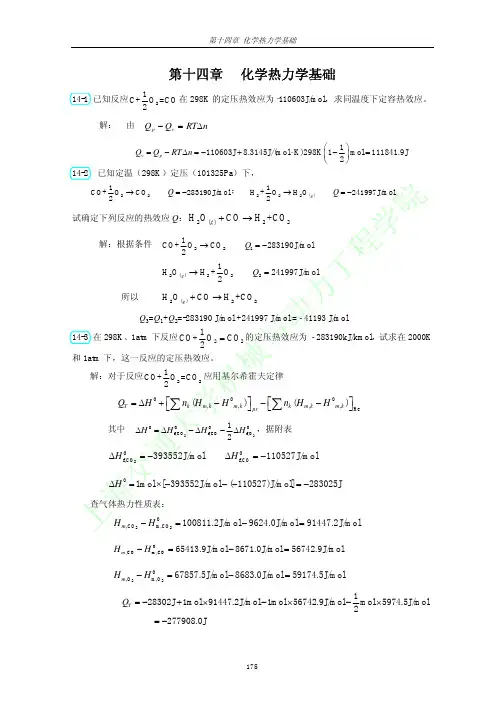
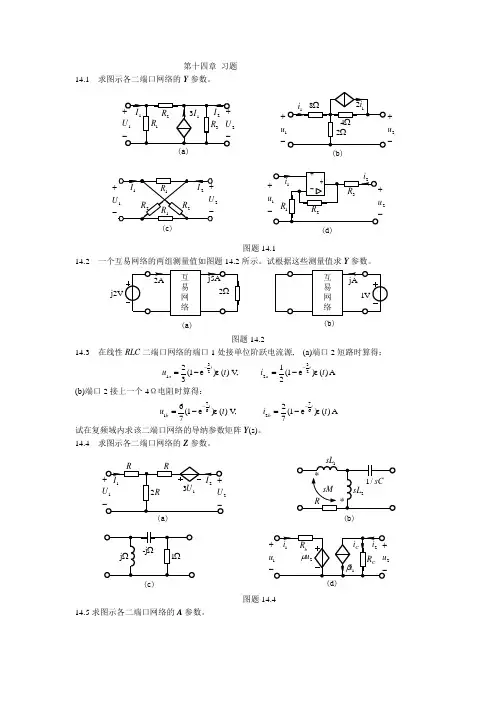
第十四章 习题 14.1 求图示各二端口网络的Y 参数。
2(a)-+u -+2u(b)2(c)2-+u (d)图题14.114.2 一个互易网络的两组测量值如图题14.2所示。
试根据这些测量值求Y 参数。
j2V(a)(b)图题14.214.3 在线性RLC 二端口网络的端口1处接单位阶跃电流源, (a)端口2短路时算得:)(ε)e1(32231t u t a --=V , )(ε)e 1(21232t i t a --=A(b)端口2接上一个4Ω电阻时算得:)(ε)e1(76671t u t b --=V , )(ε)e1(72672t i t b --=A试在复频域内求该二端口网络的导纳参数矩阵Y(s)。
14.4 求图示各二端口网络的Z 参数。
(a)(b)(c)u 2(d)图题14.414.5求图示各二端口网络的A 参数。
(a)(b)(c):(d)图题14.514.6 图示二端口网络。
当开关S 断开时测得V 3,V 5V,9213===U U U ;开关S 接通时测得V 2,V 4V,8213===U U U 。
求网络N 的传输参数矩阵A 。
Ω6图题14.614.7 求图示各二端口网络的H 参数。
(a)2(b):(d)图题14.714.8 设二端口网络的阻抗参数Ω⎥⎦⎤⎢⎣⎡=5334Z 。
(1)求它的混合参数矩阵H ;(2)若A 101=i ,V 202=u ,求它消耗的功率。
14.9 试绘出对应于下列开路阻抗矩阵的任一种二端口网络模型。
(a)Ω⎥⎦⎤⎢⎣⎡2113; (b)Ω⎥⎦⎤⎢⎣⎡++s sss/23/2/2/41; (c)Ω⎥⎦⎤⎢⎣⎡-442314.10 证明给定Y 参数可以用图题14.10所示电路来等效,求等效电路参数。
-+U2图题4.10 图题4.1114.11 证明给定Z 参数可以用图题14.11所示电路来等效,求等效电路参数。
14.12 图示电路可以用来等效二端口网络。
第十四章第一节《热机》1. 除了飞机、汽车、摩托车之外,你还知道哪些地方用到了热机?你列举的这些热机中哪些是内燃机?2. 在图14.1-6 中,甲为四冲程内燃机吸气冲程的示意图,图中画出了吸气冲程中活塞和曲轴的位置和进气门、排气门的开闭情况。
请在图乙、丙、丁中,分别画出压缩、做功、排气冲程中活塞和曲轴的位置和进气门、排气门的开闭情况。
图14.1-6 画出各冲程中活塞、曲轴的位置以及阀门的开闭情况3. 从能量转化的角度看,一台四冲程内燃机在一个循环中(1)哪个冲程存在着化学能转化为内能的过程?(2)哪个冲程存在着内能转化为机械能的过程?(3)哪个冲程具有很明显的机械能转化为内能的过程?4. 柴油机和汽油机的工作过程有什么相同点,有什么不同点?第十四章第一节《热机》课后习题答案1.轮船、拖拉机、小型农业机械、火车等都用到了热机,这些热机也都是内燃机。
2.图略。
要点提示:压缩冲程进排气门都关闭,活塞向上运动。
做功冲程进排气门都关闭活塞向下运动。
排气冲程进气门闭合,排气门打开活塞向上运动。
3.(1)做功冲程(2)做功冲程(3)压缩冲程4.柴油机和汽油机的相同点:都是燃料在气缸内燃烧;都是将内能转化为机械能的机器;都是由吸气、压缩、做功、排气四个冲程构成一个工作循环,曲轴和飞轮转两周对外做功一次;排气冲程排出废气;启动时都要靠外力先使飞轮和曲轴转动起来。
不同点:燃料不同(汽油、柴油),构造不同(火花塞、喷油嘴);吸气冲程吸入物质不同(汽油和空气混合物,柴油机只吸入空气),缸内气压、与温度高低不同(汽油机低,柴油机高)点火方式不同(汽油机是点燃式,柴油机是压燃式),效率不同(汽油机效率低,柴油机效率高)。
另外汽油机机体轻便,主要用于小汽车、摩托车,柴油机机体笨重,主要用于载重汽车,拖拉机、火车、轮船第十四章第二节《热机的效率》1. 汽油的热值为4.6×107 J/kg。
这个数值究竟有多大?有人通过一个具体例子来认识汽油热值的大小:一个60 kg 的人,从大厦的1 楼步行至第11 楼(走了10 层楼),每层楼的层高为3 m,他克服重力做了多少焦耳的功?如果汽油完全燃烧获得热量的焦耳数和这些功相等,需要汽油的质量是多少?这大约相当于生活中什么物体的质量?2. 如果燃烧干木柴跟燃烧煤油放出的热量相等,干木柴的质量应该等于煤油质量的几倍?请列出相关计算式来说明理由。
习题十四14-1 自然光是否一定不是单色光?线偏振光是否一定是单色光?答:自然光不能说一定不是单色光.因为它只强调存在大量的、各个方向的光矢量,并未要求各方向光矢量的频率不一样.线偏振光也不一定是单色光.因为它只要求光的振动方向同一,并未要求各光矢的频率相同.14-2 用哪些方法可以获得线偏振光?怎样用实验来检验线偏振光、部分偏振光和自然光? 答:略.14-3 一束光入射到两种透明介质的分界面上时,发现只有透射光而无反射光,试说明这束光是怎样入射的?其偏振状态如何?答:这束光是以布儒斯特角入射的.其偏振态为平行入射面的线偏振光.14-4 什么是光轴、主截面和主平面?什么是寻常光线和非常光线?它们的振动方向和各自的主平面有何关系?答:略.14-5 在单轴晶体中,e 光是否总是以e n c /的速率传播?哪个方向以0/n c 的速率传播? 答:e 光沿不同方向传播速率不等,并不是以0/n c 的速率传播.沿光轴方向以0/n c 的速率传播.14-6是否只有自然光入射晶体时才能产生O 光和e 光?答:否.线偏振光不沿光轴入射晶体时,也能产生O 光和e 光.14-7投射到起偏器的自然光强度为0I ,开始时,起偏器和检偏器的透光轴方向平行.然后使检偏器绕入射光的传播方向转过130°,45°,60°,试分别求出在上述三种情况下,透过检偏器后光的强度是0I 的几倍?解:由马吕斯定律有0o 2018330cos 2I I I ==0ο2024145cos 2I I I ==0ο2038160cos 2I I I ==所以透过检偏器后光的强度分别是0I 的83,41,81倍. 14-8 使自然光通过两个偏振化方向夹角为60°的偏振片时,透射光强为1I ,今在这两个偏振片之间再插入一偏振片,它的偏振化方向与前两个偏振片均成30°,问此时透射光I 与1I 之比为多少?解:由马吕斯定律ο20160cos 2I I =80I =32930cos 30cos 20ο2ο20I I I == ∴ 25.2491==I I14-9 自然光入射到两个重叠的偏振片上.如果透射光强为,(1)透射光最大强度的三分之一,(2)入射光强的三分之一,则这两个偏振片透光轴方向间的夹角为多少?解:(1) max 120131cos 2I I I ==α又20max I I = ∴,601I I = 故 'ο11124454,33cos ,31cos ===ααα. (2) 0220231cos 2I I I ==α∴'ο221635,32cos ==αα 14-10 一束自然光从空气入射到折射率为1.40的液体表面上,其反射光是完全偏振光.试求:(1)入射角等于多少?(2)折射角为多少?解:(1),140.1tan 0=i ∴'ο02854=i(2) 'ο0ο323590=-=i y14-11 利用布儒斯特定律怎样测定不透明介质的折射率?若测得釉质在空气中的起偏振角为58°,求釉质的折射率. 解:由158tan οn =,故60.1=n 14-12 光由空气射入折射率为n 的玻璃.在题14-12图所示的各种情况中,用黑点和短线把反射光和折射光的振动方向表示出来,并标明是线偏振光还是部分偏振光.图中.arctan ,00n i i i =≠题图14-12解:见图.题解14-12图题14-13图*14-13如果一个二分之一波片或四分之一波片的光轴与起偏器的偏振化方向成30°角,试问从二分之一波片还是从四分之一波片透射出来的光将是:(1)线偏振光?(2)圆偏振光?(3)椭圆偏振光?为什么?解:从偏振片出射的线偏振光进入晶(波)片后分解为e o ,光,仍沿原方向前进,但振方向相互垂直(o 光矢垂直光轴,e 光矢平行光轴).设入射波片的线偏振光振幅为A ,则有 A.2130sin ,A 2330cos οο====A A A A o e ∴e o A A ≠ e o , 光虽沿同一方向前进,但传播速度不同,因此两光通过晶片后有光程差.若为二分之一波片,e o ,光通过它后有光程差2λ=∆,位相差πϕ=∆,所以透射的是线偏振光.因为由相互垂直振动的合成得ϕϕ∆=∆-+22222sin cos 2e o e o A A xy A y A x∴ 0)(2=+e o A y A x即 x A A y o e -= 若为四分之一波片,则e o ,光的,4λ=∆位相差2πϕ=∆,此时1sin ,0cos =∆=∆ϕϕ∴ 12222=+e o A y A x即透射光是椭圆偏振光.*14-14 将厚度为1mm 且垂直于光轴切出的石英晶片,放在两平行的偏振片之间,对某一波长的光波,经过晶片后振动面旋转了20°.问石英晶片的厚度变为多少时,该波长的光将完全不能通过?解:通过晶片的振动面旋转的角度ϕ与晶片厚度d 成正比.要使该波长的光完全不能通过第二偏振片,必须使通过晶片的光矢量的振动面旋转ο90.∴ 1212::d d =ϕϕ mm 5.412090οο1122=⨯==d d ϕϕ。
第十四章产品市场和货币市场的一般均衡1.自发投资支出增加10亿美元,会使IS()。
A.右移10亿美元;B.左移10亿美元;C.右移支出乘数乘以10亿美元;D.左移支出乘数乘以10亿美元。
解答:C2.如果净税收增加10亿美元,会使IS()。
A.右移税收乘数乘以10亿美元;B.左移税收乘数乘以10亿美元;C.右移支出乘数乘以10亿美元;D.左移支出乘数乘以10亿美元。
解答:B3.假定货币供给量和价格水平不变,货币需求为收入和利率的函数,则收入增加时()。
A.货币需求增加,利率上升;B.货币需求增加,利率下降;C.货币需求减少,利率上升;D.货币需求减少,利率下降。
解答:A4.假定货币需求为L=ky-hr,货币供给增加10亿美元而其他条件不变,则会使LM()。
A.右移10亿美元;B.右移k乘以10亿美元;C.右移10亿美元除以k(即10÷k);D.右移k除以10亿美元(即k÷10)。
解答:C5.利率和收入的组合点出现在IS曲线右上方、LM曲线左上方的区域中,则表示()。
A.投资小于储蓄且货币需求小于货币供给;B.投资小于储蓄且货币需求大于货币供给;C.投资大于储蓄且货币需求小于货币供给;D.投资大于储蓄且货币需求大于货币供给。
解答:A6.怎样理解IS—LM模型是凯恩斯主义宏观经济学的核心?解答:凯恩斯理论的核心是有效需求原理,认为国民收入决定于有效需求,而有效需求原理的支柱又是边际消费倾向递减、资本边际效率递减以及心理上的流动偏好这三个心理规律的作用。
这三个心理规律涉及四个变量:边际消费倾向、资本边际效率、货币需求和货币供给。
在这里,凯恩斯通过利率把货币经济和实物经济联系了起来,打破了新古典学派把实物经济和货币经济分开的两分法,认为货币不是中性的,货币市场上的均衡利率会影响投资和收入,而产品市场上的均衡收入又会影响货币需求和利率,这就是产品市场和货币市场的相互联系和作用。
但凯恩斯本人并没有用一种模型把上述四个变量联系在一起。
第十四章含氮有机化合物(P125-129) 1.给出下列化合物的名称或写出结构式:(1)(2)(3)(4)(5)(6)(7)对硝基氯化苄(9)(8)(10)苦味酸(11)1,4,6-三硝基萘2.按其碱性的强弱排列下列各组化合物,并说明理由:(1) NH2NH2NH2 O2N H3C(2) 乙酰胺、甲胺和氨3.比较正丙醇、正丙胺、甲乙胺、三甲胺和正丁烷的沸点高低并说明理由:4.如何完成下列转变:(1)(2)由到(3) 由到(4) 由到5.完成下列反应,并指出最后产物的构型是(R)或(S):(1) SOCl 232-6.完成下列反应:(1)N HCH 3322?加热??(1) CH 3I (2)Ag 2O,H 2O (3) 加热CH 3CH 3O 2NFe+HCl?(CH 3CO)2O??H +,H 2O?NaNO 2,HCl??O 2NCH 3(2)(3)OCH 3OCH 3H 2N(4)(5)2(6)CH 3CH 2CH 2NH 2(7)NH-COCH 3BrHNO AcOH?(8)NO 2F O 2N+N HCH 3O2?(9)N H+CH 3H +?CH 2=CHCOOEt?H +?(10)N +3CH3H 3C-?加热7.指出下列重排反应的产物:(1)(2)(3(4)(5)(6) ? ??(7) ? ?(8)8.解释下述实验现象:(1) 对溴甲苯与NaOH在高温下反应,生成几乎等量的对和间甲苯酚。
(2) 2,4-二硝基氯苯可以由氯苯硝化得到,但如果反应产物用NaHCO3水溶液洗涤除酸则得不到产品。
9.请判断下述霍夫曼重排反应能否实现,为什么?9. 完成下列反应,并为该反应提供一个合理的反应机理。
(3)解:本题为Hofmann重排类型的题目。
只是反应体系发生了变化,NaOH水溶液改变了CH3ONa的甲醇溶液,所以最后形成的是较稳定的氨基甲酸甲酯,,而不是易分解的氨基甲酸。
10.从指定原料合成:(1)从环戊酮和HCN制备环己酮;(2)从1,3-丁二烯合成尼龙-66的两个单体-己二酸和己二胺;(3)由乙醇、甲苯及其他无机试剂合成普鲁卡因(4)由简单的开链化合物合成11.选择适当的原料经偶联反应合成:(1)2,2′-二甲基-4-硝基-4′-氨基偶氮苯(2)12.从甲苯或苯开始合成下列化合物:(1)间氨基苯乙酮 (2)邻硝基苯胺(3)间硝基苯甲酸 (4)1,2,3-三溴苯(5) (6)13.试分离PhNH2、PhNHCH3和PhN(CH3)2:14.某化合物C8H9NO2(A)在NaOH中被Zn粉还原产生B,在强酸性下B重排生成芳香胺C,C用HNO2处理,再与H3PO2反应生成3,3-二乙基联苯(D)。
第十四章控制与控制过程Document number【SA80SAB-SAA9SYT-SAATC-SA6UT-SA18】第十四章控制与控制过程一、习题(一)填充题1、控制是为了保证_________与_________适应的管理职能。
2、控制工作的主要内容包括_________、_________和_________。
3、预先控制的内容包括_________和_________两个方面。
4、成果控制的主要作用,是通过总结过去的经验和教训,为_________提供借鉴。
5、成果控制主要包括_________、_________、_________以及_________等内容。
6、企业应根据_________和_________来确定控制的范围和频度,建立有效的控制系统。
7、适度控制是指控制的_________、_________和_________要恰到好处。
8、控制的过程都包括三个基本环节的工作:_________、_________和_________。
9、一般来说,企业可以使用的建立标准的方法有三种:_________、_________、_________ 。
10、工程标准也是一种用统计方法制定的控制标准,不过它不是对历史性统计资料的分析,而是通过对_________ 。
11、在采取任何纠正措施以前,必须首先对_________。
12、一般地说,弹性控制要求企业制定_________和_________。
(二)选择题1、有效的控制要求_________A. 选择关键的经营环节B. 确定恰当的控制频度C. 收集及时的信息D. 合理运用预算或非预算的控制手段2、根据确定控制标准Z值的方法,控制过程可以分为_________。
A.程序控制B.跟踪控制C.最佳控制D.自适应控制3、在企业生产经营活动中,属于跟踪控制性质的有_________。
A. 税金的交纳B. 利润、工资、奖金的分配C. 信息控制程序D. 资金、材料的供应4、_________都是应用了最佳控制原理进行决策和管理。
1、电子束入射固体样品表面会激发哪些信号?它们有哪些特点和用途?答:具有高能量的入射电子束与固体样品表面的原子核以及核外电子发生作用,产生下图所示的物理信号:①背散射电子背散射电子是指被固体样品中的原子核反弹回来的一部分入射电子,其中包括弹性背散射电子和非弹性背散射电子。
弹性背散射电子是指被样品中原子核反弹回来的散射角大于90°的那些入射电子,其能量基本上没有变化。
非弹性背散射电子是入射电子和核外电子撞击后产生非弹性散射而造成的,不仅能量变化,方向也发生变化。
背散射电子来自样品表层几百纳米的深度范围。
由于背散射电子的产额随原子序数的增加而增加,所以,利用背散射电子作为成像信号不仅能分析形貌特征,也可用来显示原子序数衬度,定性地进行成分分析。
②二次电子二次电子是指被入射电子轰击出来的核外电子。
二次电子来自表面50-500 Å的区域,能量为0-50 eV。
它对试样表面状态非常敏感,能有效地显示试样表面的微观形貌。
由于它发自试样表面层,入射电子还没有较多次散射,因此产生二次电子的面积与入射电子的照射面积没多大区别。
所以二次电子的分辨率较高,一般可达到50-100 Å。
扫描电子显微镜的分辨率通常就是二次电子分辨率。
二次电子产额随原子序数的变化不明显,它主要决定于表面形貌。
③吸收电子入射电子进入样品后,经多次非弹性散射,能量损失殆尽(假定样品有足够厚度,没有透射电子产生),最后被样品吸收,此即为吸收电子。
入射电子束射入一含有多元素的样品时,由于二次电子产额不受原子序数影响,则产生背散射电子较多的部位其吸收电子的数量就较少。
因此,吸收电流像可以反映原子序数衬度,同样也可以用来进行定性的微区成分分析。
④透射电子如果样品厚度小于入射电子的有效穿透深度,那么就会有相当数量的入射电子能够穿过薄样品而成为透射电子。
一般用它对薄样品进行成像和衍射分析。
样品下方检测到的透射电子信号中,除了有能量与入射电子相当的弹性散射电子外,还有各种不同能量损失的非弹性散射电子。
其中有些待征能量损失ΔE的非弹性散射电子和分析区域的成分有关,因此,可以用特征能量损失电子配合电子能量分析器来进行微区成分分析。
⑤特性X射线特征X射线是原子的内层电子受到激发以后,在能级跃迁过程中直接释放的具有特征能量和波长的一种电磁波辐射。
发射的X射线波长具有特征值,波长和原子序数之间服从莫塞莱定律。
因此,原子序数和特征能量之间是有对应关系的,利用这一对应关系可以进行成分分析。
如果用X射线探测器测到了样品微区中存在某一特征波长,就可以判定该微区中存在的相应元素。
⑥俄歇电子如果原子内层电子能级跃迁过程中释放出来的能量不以X 射线的形式释放,而是用该能量将核外另一电子打出,脱离原子变为二次电子,这种二次电子叫做俄歇电子。
因为每一种原子都有自己特定的壳层能量,所以它们的俄歇电子能量也各有特征值,一般在50-1500 eV 范围之内。
俄歇电子是由试样表面极有限的几个原子层中发出的,这说明俄歇电子信号适用于表层化学成分分析。
2、扫描电镜的分辨率受哪些因素影响,用不同的信号成像时,其分辨率有何不同?所谓扫描电镜的分辨率是指用何种信号成像时的分辨率?答:在其他条件相同的情况下(如信噪比、磁场条件及机械振动等)电子束束斑大小,检测信号的类型,检测部位的原子序数是影响扫描电镜分辨率的三大因素。
用不同信号成像,其分辨率相差较大,列表说明:3、扫描电镜的成像原理与透时电镜有何不同?答:两者完全不同。
透射电镜用电磁透镜放大成像,而扫描电镜则是以类似电视机摄影显像的方式,利用细聚焦电子束在样品表面扫描时激发出的各种物理信号来调制而成。
4、二次电子像和背散射电子像在显示表面形貌衬度时有何相同与不同之处?答:相同处:均利用电子信号的强弱来行成形貌衬度不同处:① 分辨率不同。
背散射电子是在一个较大的作用体积内被入射电子激发出来的,成像单元较大,因而分辨率较二次电子像低。
② 能量和运动轨迹不同。
背散射电子能量较高,以直线逸出,因而样品背部的电子无法被检测到,成一片阴影,衬度较大,无法分析细节;利用二次电子作形貌分析时,可以利用在检测器收集光栅上加上正电压来吸收较低能量的二次电子,使样品背部及凹坑等处逸出的电子以弧线状运动轨迹被吸收,因而使图像层次增加,细节清晰。
5、说明背散射电子像和吸收电子像的原子序数衬度形成原理,并举例说明在分析样品中元素元素分布的应用。
答:右图显示原子序数对背散射电子产额的影响。
随着原子序数Z 增大,产额增大。
样品表面平均原子序数大的微区,背散射电子信号强度较高,可以根据背散射电子像的亮暗衬度来判断相应区域原子序数的相对高低,对金属及其合金进行定性成分分析。
吸收电子也是对样品中原子序数敏感的一种物理信号。
由入射电子束于样品的相互作用可知:i I =i B +i A +i T +i S 式中,i I 是入射电子流,i B ,i T 和i S 分别代表背散射电子,透射电子,二次电子的电流,而i A 为吸收电子电流。
对信号 二次电子 背散射电子 吸收电子 特征X 射线 俄歇电子 分辨率(nm ) 5~10 50~200 100~1000 100~1000 5~10于样品厚度足够大时,入射电子不能穿透样品,所以透射电子电流为零,这时的入射电子电流可表示为:i I =i B+i A +i S,由于二次电子信号与原子序数无关(可设i S=C),则吸收电子电流为:i A = (i I -C) - i B在一定条件下,入射电子束电流是一定的,所以吸收电流与背散射电流存在互补关系。
因此,吸收电子像的衬度是与背散射电子和二次电子的衬度互补的。
所以,背散射电子图像上的亮区在相应的吸收电子图像上必定是暗区。
奥氏体铸铁的显微组织(a)背散射电子像(b)吸收电子像在图上可以看出,在背散射电子像上的石墨条呈现暗的衬度,而在吸收电子像上呈现亮的衬度。
6、当电子束入射重元素和轻元素时,其作用体积有何不同?各自产生的信号分辨率有何特点?答:作用体积分辨率吸收或散射出样品表面之前将在这个体积中活动。
俄歇电子和二次电子因其本身能量较低以及平均自由程很短,只能在样品的浅层表面内逸出,在一般情况下能激发出俄歇电子的样品表层厚度约为0.5-2nm,激发二次电子的层深为5-10nm范围。
入射电子束进入浅层表面时,尚未向横向扩展开来,因此,俄歇电子和二次电子只能在一个和入射电子束斑直径相当的圆柱体内被激发出来,因为束斑直径就是一个成像检测单元(像点)的大小,所以这两种电子的分辨率就相当于束斑的直径。
②重元素:电子束入射重元素样品中时,作用体积不呈滴状,而是半球状。
电子束进入表面后立即向横向扩展,因此在分析重元素时,即使电子束的束斑很细小,也不能达到较高的分辨率,此时二次电子的分辨率和背散射电子的分辨率之间的差距明显变小。
7、二次电子像景深很大,样品凹坑底部都能清楚地显示出来,从而使图像的立体感很强,其原因何在?答:用二次电子信号作形貌分析时,在检测器收集栅上加以一定大小的正电压(一般为250-500V),来吸引能量较低的二次电子,使它们以弧线路线进入闪烁体,这样在样品表面某些背向检测器或凹坑等部位上逸出的二次电子也对成像有所贡献,图像景深增加,细节清楚。
一、选择题1、仅仅反映固体样品表面形貌信息的物理信号是(B )。
A. 背散射电子;B. 二次电子;C. 吸收电子;D.透射电子。
2、在扫描电子显微镜中,下列二次电子像衬度最亮的区域是(B )。
A.和电子束垂直的表面;B. 和电子束成30º的表面;C. 和电子束成45º的表面;D. 和电子束成60º的表面。
3、可以探测表面1nm层厚的样品成分信息的物理信号是(D )。
A. 背散射电子;B. 吸收电子;C. 特征X射线;D. 俄歇电子。
二、判断题1、扫描电子显微镜中的物镜与透射电子显微镜的物镜一样。
(×)2、扫描电子显微镜的分辨率主要取决于物理信号而不是衍射效应和球差。
(√)3、扫描电子显微镜的衬度和透射电镜一样取决于质厚衬度和衍射衬度。
(×)4、扫描电子显微镜具有大的景深,所以它可以用来进行断口形貌的分析观察。
(√)三、填空题1、电子束与固体样品相互作用可以产生背散射电子、二次电子、透射电子、特征X射线、俄歇电子、吸收电子等物理信号。
2、扫描电子显微镜的放大倍数是阴极射线电子束在荧光屏上的扫描宽度与电子枪电子束在样品表面的扫描宽度的比值。
在衬度像上颗粒、凸起的棱角是亮衬度,而裂纹、凹坑则是暗衬度。
3、分辨率最高的物理信号是俄歇电子或二次电子为5 nm,分辨率最低的物理信号是特征X射线为100 nm以上。
4、扫描电镜的分辨率是指二次电子信号成像时的分辨率5、扫描电子显微镜可以替代金相显微镜进行材料金相观察,也可以对断口进行分析观察。
6、扫描电子显微镜常用的信号是二次电子和背散射电子。
7、扫描电子显微镜是电子光学系统,信号收集处理、图像显示和记录系统,真空系统三个基本部分组成。
8、电子光学系统包括电子枪、电磁透镜、扫描线圈和样品室。
四、名词解释1、背散射电子:入射电子被样品原子散射回来的部分;它包括弹性散射和非弹性散射部分;背散射电子的作用深度大,产额大小取决于样品原子种类和样品形状。
2、吸收电子:入射电子进入样品后,经多次非弹性散射,能量损失殆尽(假定样品有足够厚度,没有透射电子产生),最后被样品吸收。
吸收电流像可以反映原子序数衬度,同样也可以用来进行定性的微区成分分析。
3、特征X射线:原子的内层电子受到激发以后,在能级跃迁过程中直接释放的具有特征能量和波长的一种电磁波辐射。
利用特征X射线可以进行成分分析。
4、二次电子:二次电子是指被入射电子轰击出来的核外电子。
二次电子来自表面50-100 Å的区域,能量为0-50 eV。
它对试样表面状态非常敏感,能有效地显示试样表面的微观形貌。
5、俄歇电子:如果原子内层电子能级跃迁过程中释放出来的能量不以X射线的形式释放,而是用该能量将核外另一电子打出,脱离原子变为二次电子,这种二次电子叫做俄歇电子。
俄歇电子信号适用于表层化学成分分析。
五、问答题1、扫描电子显微镜有哪些特点?答:和光学显微镜相比,扫描电子显微镜具有能连续改变放大倍率,高放大倍数,高分辨率的优点;扫描电镜的景深很大,特别适合断口分析观察;背散射电子成像还可以显示原子序数衬度。
和透射电子显微镜相比,扫描电镜观察的是表面形貌,样品制备方便简单。
2、扫描电子显微镜的放大倍数是如何调节的?试和透射电子显微镜作一比较。
答:扫描电子显微镜的放大倍数是通过扫描放大控制器调节的,光栅扫描的情况下,若电子束在样品表面上扫描振幅A S,电子束在荧光屏上的扫描振幅A c,则扫描电子显微镜的放大倍数M=A c/A s,通常照相用的阴极射线管荧光屏尺寸为100×100mm,即A c=100mm,而电子束在样品表面上扫描振幅A S可根据需要通过扫描放大控制器来调节。